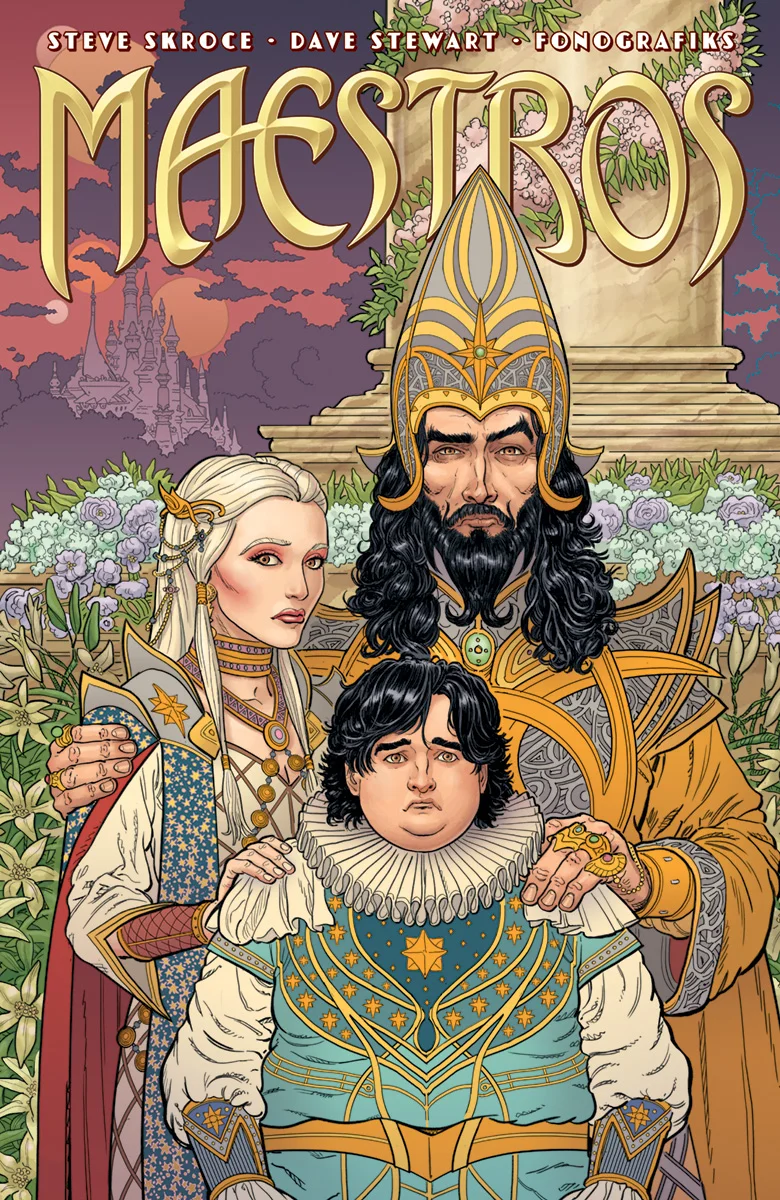Maestros #4 Review
The biggest draw to independent comics for creators and fans alike is the near limitless freedom that come with an artist having creative control of a product, and using that freedom to make stories or characters that might be too extreme for licensed work at the Big 2. Steve Skroce proves this principle, writing and illustrating his own independent comic, Maestros, a very graphic, high concept fantasy that captivates visually as much as it challenges its readers pre-conceived notions of its genre. Maestros #4 does a spectacular job answering plot related questions that have arisen since issue #1, while also entertaining readers with unique style and a trope breaking script.
The story of Maestros revolves around a man named Willy, the last Kahzar, heir to the throne of all reality, and the latest bearer of the magical title Maestros. In the history of the series canon there has been a Maestros since the beginning of time who has overseen, shaped, and manipulated reality to their design, with the lone exception of Earth: Earth was a world made without magic and is where Willy’s mother Margaret hails from, as well as where Willy was raised initially, the comic employing flashbacks of both Earthlings for several issues using them as audience surrogates to ask the questions about the world and contrasting their modern sensibilities with the the barberic philosophies of the fantasy based characters.
And what a clash it is. The events in Maestros can shift from awe and wonder to horror and disgust, with every emotion being drawn out from the reader thanks to Skroce’s detailed art, which can go from stunning to viscerally gory, sometimes within the same panel. The world of the Maestros that Willy and his mother entered is not only full of but supports classism, racism, moral absolutism, and gruesome punishments from the simplest crimes: like a scene from Willy’s childhood in issue #2 where he was flayed alive for reading some magical manuals non-permissible for his age at the time.
The reader actually learns in issue #4 it was Willy rebuking his father’s barberism, refusing to kill a demon princess in cold blood, that formed the catalyst for his leaving the magical realms. Though Willy is initially due to be executed for his “crime,” Margaret goes on a very painful quest to earn both of them the sentence of banishment--the same banishment that spared both of their lives from a family wide massacre, leading Willy to take the throne at the end of issue #1.
The implementation of the flashback framing device, is in a way, a covenant between the story and its reader: a promise to unveil the mysteries of the past while the story progresses in the present, and that promise is fulfilled expertly in issue #4. During the present day half of the comic, Willy goes to the demon underworld in search of aid from the demon princess he saved in the flashback portion. Skroce did a masterful job here as a writer: building a commonality between two big events in past and present that are blended together in a satisfying way.
The demon adventure in general is amusing, playing to two of Maestros key strengths of dark humor and subverting audience expectation. Maestros subverts the character races and archetypes in a fantasy setting but does not go for a clear-cut “good demons and evil elves” narrative, instead exploring the much more realistic and compelling idea that an individual can have negative and positive traits to varying degrees.
With that knowledge ahead of time, it is a real toss up in how an underworld would work in this universe. Willy is there seeking help from the demons, and at first tries to keep his biases in check, until he finds demons engaging the gruesome cannibalistic behavior he was told by his father. So he then changes his behavior to what he was taught in engaging demons, and in doing so causes more trouble for himself when a different situation was actually more than it appeared. It’s all really well done as a comedy of errors that serves the humor and demonstrates the series’ larger themes.
Skroce’s art is a wonder to look at, with fascinating set and character design, fully realized with his copious amounts of eye catching detail. The worlds and characters that inhabit this universe may be based on several classic races depicted in fantasy based works, but Skroce’s style gives them all so much identity that they become unique and fresh. Plus, the way he depicts body language and facial reactions for comedic effect visually craft a story.
There are only two more issues left of the main story arc after issue #4, and Skroce has continued to help his book stand out through smart writing and beautiful art. The comedy is on point, its satire is thought provoking, and long-term readers will be satisfied that their time and attention continues to be rewarded through answers of the past as the series heads into its penultimate issue.
B+










